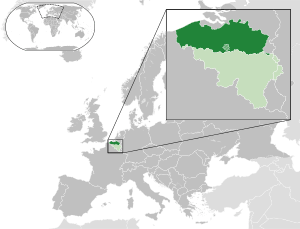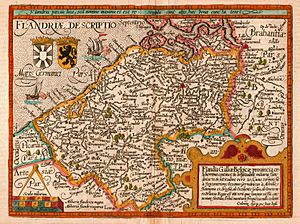Flemish people facts for kids

Flag of Flanders, a symbol of the Flemish people.
|
|

Flemish Community in Belgium and Europe
|
|
| Total population | |
|---|---|
| c. 7 million (2011 estimate) |
|
| Regions with significant populations | |
| 6,450,765 | |
| Indeterminable (352,630 Belgians) |
|
| 187,750 | |
| 13,840–176,615 | |
| 55,200 | |
| 15,130 | |
| 6,000 | |
| Languages | |
| Dutch (Flemish Dutch) | |
| Religion | |
| Traditionally: Roman Catholic majority Protestant and Jewish minorities |
|
| Related ethnic groups | |
|
|
|
U.S. population census does not differentiate between Belgians and Flemish, therefore the number of the latter is unknown. Flemish people might also indiscriminately identify as Dutch, due to their close association, shared history, language and cultural heritage. There were as many as 4.27 million Dutch Americans, unknown percentage of which might be Flemings. In 2011, 13,840 respondents stated Flemish ethnic origin. Another 176,615 reported Belgian. See List of Canadians by ethnicity |
|
The Flemish people (called Vlamingen in Dutch) are a West Germanic group. They live mainly in Flanders, which is a part of Belgium. They speak a type of Dutch called Flemish Dutch.
Flemings are one of the two main groups in Belgium. The other group is the Walloons, who speak French. Flemings make up most of Belgium's population, about 60%.
Long ago, "Flemish" was a name for anyone living in the medieval County of Flanders. This area included parts of modern-day Belgium, France, and the Netherlands. It didn't matter what their background or language was. Today, Flanders is a smaller region. It includes parts of the old County of Flanders, plus parts of the medieval duchy of Brabant and the county of Loon. This is where the modern Flemish people and their culture slowly developed.
Contents
History of the Flemish People
The idea of being "Flemish" became much stronger after the Belgian Revolution in 1830. Before this, the word "Flemings" mostly meant people from the old County of Flanders. However, since the 1300s, "Flemish" also described the language spoken in Flanders and the Duchy of Brabant. The Belgian province of Limburg was not part of this area at first. It only became known as "Flemish" in the 1800s.
Belgium's Independence
In 1830, the southern parts of the United Kingdom of the Netherlands decided to become independent. There were several reasons for this:
- People who spoke French, especially leaders, worried about losing their power under Dutch rule.
- Fast growth in factories in the south showed economic differences.
- Under earlier French rule (1794–1815), French was the only official language. This made many important people speak French.
- The Dutch king allowed both Dutch and French in Flemish areas. He also tried to bring Dutch back into schools.
- Most people in the south were Catholic. They didn't trust the Protestant king, William I of the Netherlands. The Catholic Church also encouraged this distrust.
- Some people who wanted more freedom were unhappy with King William's strict rule.
After the revolt, the first Dutch language laws were removed. New laws then limited the use of Dutch. This led to the rise of the Flemish Movement. This movement wanted to correct past unfairness against Dutch speakers. Over the next 150 years, this movement helped Dutch become equal in society, politics, and language by the late 1800s.
Flemish Migration to the Azores
After the Hundred Years' War, many Flemings moved to the Azores islands. By 1490, about 2,000 Flemings lived there. Willem van der Haegen was a sea captain who brought settlers from Flanders to the Azores. Today, many people in the Azores can trace their family history back to Flanders. Some of their traditions are still very Flemish, like using windmills for grain. They also have special cheeses like São Jorge cheese and religious events such as the feast of the Cult of the Holy Spirit.
Flemish Identity and Culture
Within Belgium, Flemings are a distinct group because of their language and customs. However, when compared to the Netherlands, many of these differences are smaller. Flemings share the same language, similar customs, and traditional religion (especially with the southern Netherlands) with the Dutch.
Even so, Flemings usually don't see themselves as Dutch, and vice versa. This is partly because of common ideas about Northern and Southern cultures. Also, the history of the Flemish culture gaining its rights in Belgium has given many Flemings a strong sense of their own national identity. Besides this, people also feel a strong connection to their local province, city, region, or the dialect they speak.
Language of the Flemings
Flemings speak Dutch. They use a southern version of the language, often called 'Flemish' in everyday talk. Dutch is the main language in Belgium, spoken by three out of five people. The different Flemish dialects have unique words and some grammar differences from standard Dutch. Like in the Netherlands, a speaker's local dialect affects how they pronounce standard Dutch.
Religion of the Flemings
About 75% of Flemish people were baptized as Roman Catholic. However, fewer than 8% regularly attend church services. Nearly half of the people in Flanders consider themselves agnostic (not sure if God exists) or atheist (don't believe in God). A survey in 2006 showed that 55% of Flemings said they were religious, and 36% believed God created the universe.
National Symbols of Flanders
The official flag and coat of arms for the Flemish Community show a black lion with red claws and tongue on a yellow background. This is called or a lion rampant sable armed and langued gules in heraldry. Before 1991, a flag with a completely black lion was widely used. Today, only the flag with the red claws and tongue is official in Belgian law. The all-black lion flag is mostly used by groups who want Flanders to be separate.
The Flemish authorities also use two logos with a stylish black lion, showing the claws and tongue in either red or black. The Flemish lion was first seen on the seal of Philip d'Alsace, Count of Flanders, in 1162. The Flemish coat of arms (a black lion on yellow) was used by many counts after that. The saying "Vlaanderen de Leeuw" (Flanders the lion) was supposedly on the arms of Pieter de Coninck at the Battle of the Golden Spurs on July 11, 1302.
Flemish People Around the World
Flemings in Brazil
Many people of Belgian background live in Brazil.
Flemings in Canada
The first large group of Flemish people moved to Canada in the 1870s. Many went to Saint Boniface to work in flour mills, brick yards, and railway yards. Others moved to smaller towns in Manitoba for farm jobs. In the early 1900s, many Flemings settled across Ontario. They were especially drawn to the tobacco farming industry in towns like Chatham, Leamington, Tillsonburg, Wallaceburg, Simcoe, Sarnia, and Port Hope.
Flemings in France and the Netherlands
The original County of Flanders included areas that are now part of France and the Netherlands. These areas still have people of Flemish background and some still use Flemish Dutch. These include Zeelandic Flanders in the Netherlands and the Arrondissement of Dunkirk (also known as French Westhoek) in France. People in North Brabant also share similar family roots.
Flemings in South Africa
Many Afrikaners in South Africa have Dutch and Flemish ancestry.
Flemings in the United Kingdom
Before the 1600s, many Flemings moved to the United Kingdom. Today, several towns in England and Wales have large populations with Flemish ancestors. The first group came to England in the early 1100s. They were escaping damage from a storm in Flanders. King Henry I settled many of them in Pembrokeshire. They changed the culture and accent there so much that the area became known as Little England beyond Wales. Haverfordwest and Tenby became important towns for these Flemish settlers.
In the 1300s, another group moved to England. King Edward III encouraged them, partly because he married Philippa of Hainault. Skilled cloth weavers from Flanders were allowed to settle and help the growing cloth and wool industries. These migrants mainly settled in textile towns in Lancashire and Yorkshire. These included Manchester, Bolton, Blackburn, Liversedge, Bury, Halifax, and Wakefield.
More Flemish weavers were needed in England in the 1400s and 1500s. This time, they mostly went to towns near the coast in East Anglia and South East England. Many went to Colchester, Sandwich, and Braintree. In 1582, it was thought that about 1600 Flemings lived in Sandwich. London, Norwich, and North Walsham were also popular places. The nickname for Norwich City F.C. fans, "Canaries," comes from the fact that many Norfolk weavers kept pet canaries. The town of Whitefield, near Bury, may have gotten its name from Flemish weavers who laid their cloths out in the sun to bleach them.
Flemings in the United States
In the United States, the cities of De Pere and Green Bay in Wisconsin attracted many Flemish and Walloon immigrants in the 1800s. The small town of Belgique was settled almost entirely by Flemish immigrants. However, many residents left after the Great Flood of 1993.
See also
 In Spanish: Flamencos para niños
In Spanish: Flamencos para niños


